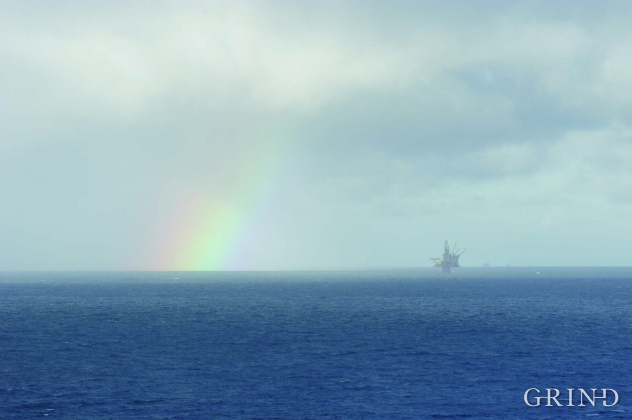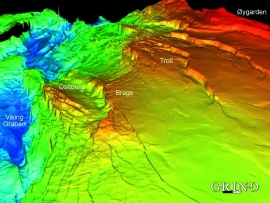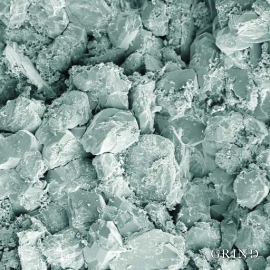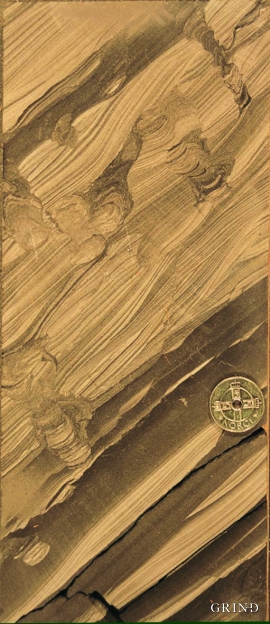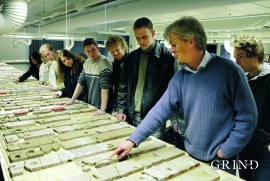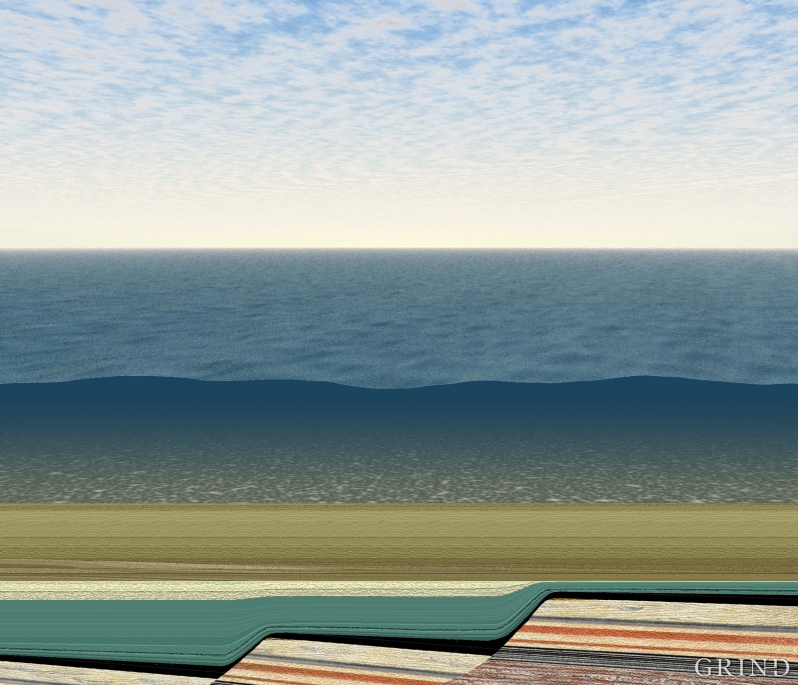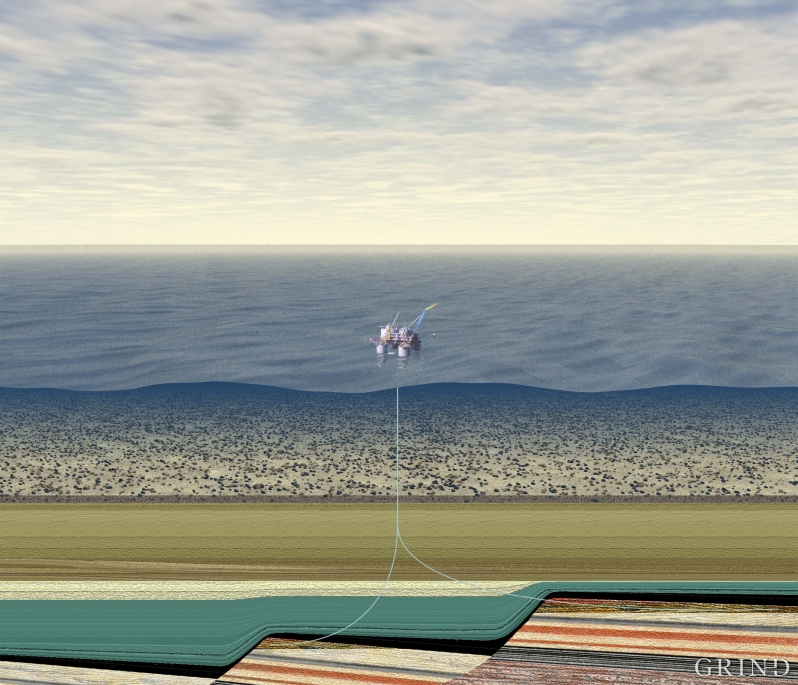Published: 28.10.2004 | Author: William Helland-Hansen
På plattformene langt ute i havet – og i kontorene på land – er tusenvis av mennesker i arbeid med å hente opp petroleum fra reservoarene et par kilometer under havbunnen. De verdifulle dråpene, dannet gjennom uendelige tidsrom, vil bli høstet i løpet av et par generasjoner. (Helge Hansen)
Already in the 1750s, Erik Pontioppidan fantasized about the possibility of petroleum in the North Sea, in "Forsøg til Norges naturlige Historie" (= Studies of Norway's Natural History) "The North Sea’s oiliness is, next to its saltiness, a remarkable feature. It can be expected that in the sea, as on land, there lie hidden some oil seepages or petroleum flows, naphtha, schist-oil and other bituminous and oily liquids”. More than 200 years were to pass before these predictions came true. In recent years, an unbelievable 120,000 cubic metres of oil and 70 million cubic metres of gas are pumped up from the Oseberg and Troll reservoirs every day. This fairy tale is being played out less than 80 kilometres from the coast of Hordaland, which is not further than that one could see the oil platforms from the coastal mountains on a clear day.
The petroleum resources in the ocean west of Hordaland are actually the result of a large dose of luck. A variety of processes in nature have combined to give a positive result - valuable petroleum that flows freely up through wells, around the clock, year after year - perhaps for as long as 50 years. Many might wonder why the sea right outside of our back door is enriched in these natural resources. And why we find oil and gas just a short distance off the coast, but not on land?
The North Sea is born
We must travel far back in geological history to find the answer - in fact, we must begin 250 million years ago in order to understand all the connections. This is when the North Sea Basin was formed - the foundation for the gigantic oil- and gas "factory" which the North Sea is notorious for. A “basin” in this context of the word is an area that receives great thicknesses of sediment, first and foremost sand and clay, over a long period of earth's history. It was tensional forces in the earth's crust in Permian and Triassic times that created the North Sea basin, the precursor of the North Sea. The basin at that time was elongated in a north-south direction, with its axis in the middle of the sea between the Shetland Islands and Hordaland, roughly from Jæren to Stadt as measured from land. As a result of the stretching, the crust grew thinner and broke up many places along fault zones. The same tensional forces also acted on Hordaland, but without great success - the meagre result was some thin cracks in the bedrock where lava flowed up, such as we can see for example in Espevikpollen at Tysnes (*p. R292) and Sildepollen in Sund (*p. R359).
At that time Scandinavia lay far to the south, in fact as far south as today's North Africa, at roughly the same latitude as the Canary Islands and Egypt. The climate was also comparably warmer and drier and the landscape was more similar to that found at such latitudes, with little vegetation and desert-like conditions. During sporadic rain showers numerous small rivers ran out from the Caledonian Mountains in Norway, which were eventually worn down (*p. ?ingen oppgitt i boka) and from the Scotland-Shetland area in the west. The rivers transported sand out onto the large river plains in the newly formed North Sea basin. During the long dry periods the water evaporated. The conditions were unfriendly towards life and resulted in an essentially a lifeless landscape. But, things were to change.
Millions of years passed, at the same time as Scandinavia moved slowly northwards - and the climate improved. From the end of the Triassic to the middle of the Jurassic (from 220 to 170 million years ago), our area moved from a latitude of roughly that where southern is Spain today, to roughly where the north of France is. It became more humid, but still warmer than conditions are today. The North Sea at that time was also surrounded by high areas where rivers laden with sand and clay began their journeys toward the lowland and out into the North Sea. The landscape in the North Sea changed in character - the dry river plains were replaced by moist swampy areas and there was a more continuous flow of water in the rivers. Outside of the river plains and swampy areas there were large deltas, with shelf areas and sea beyond. Ichthyosaurs and plesiosaurs hunted in the sea, while dinosaurs rules on land and pterosaurs dominated the skies. The coast did not stand still - the land areas were flooded over long periods and covered by shallow seas - but large quantities of sediment filled up the shallow seas again and again as the deltas "wandered out" toward the ocean and replaced the water with dry land.
The Brent- and Sognefjord Deltas
In the middle of the Jurassic just such a large delta was wandering out toward the ocean - the Brent Delta. As it wandered it washed out large quantities of sand in front of the river mouths. The sand accumulated along the shores and in the shallow waters along the coast. Further out it lay down layer upon layer of mud and clay. Eventually, most of the North Sea Basin filled up as the delta and coastal areas alongside the deltas were gradually transported northwards. A large amount of sand was left behind on the sea floor in a large belt in the northerly part of the North Sea, including an area which today comprises the Oseberg-Gullfaks- and Statfjord oil fields. The sand deposits were often several tens of metres thick and continuous over large distances - we can imagine them as gigantic, largely flat-lying "sand sheets". After the sea had yet again pushed its boundary far in over land, during the last half of the Jurassic Period, new deltas were built up, this time not from south to north, but from the west coast and outwards. Much of this sand may have come down the old river valley that later was to become Sognefjord. In any case, new deltas wandered back and forth across the area that later was to become part of Troll Field, and laid down large sand deposits because of the shallow shelf areas. One of the deltas that laid down large sand deposits has been named the "Sognefjord Delta" by geologists. It is thought that parts of this delta once stretched all the way in to Vatlestraumen between little Sotra and the mainland - remains of these sediments survived later erosion and endured because they became well hidden deep down in a fault in the bedrock. When work on the Bjorøy tunnel encountered the sand, shale and coal remains from the Jurassic, it caused considerable delays in the construction work (*p. R364).
The sand deposits from the Jurassic were later altered to sandstone where oil and gas could collect, as in the Oseberg and Troll Fields. One of the requirements for the eventual discovery of oil and gas, that which later would become the reservoir bedrock, was laid down. But far from all of the requirements had yet been met.
Giant domino pieces
At the end of the Jurassic, roughly 160 million years ago, when the deltas were finished wandering back and forth across the North Sea basin, an important geological phenomenon occurred: The North Sea once again got stretched and thinned - in the same way as when the Basin was "born" in the Permian. Also this time, the tensional forces acted in an east-west direction - and again, the earth's crust got broken up along fault zones. The crust got divided up into many smaller pieces, each bounded by faults. We can imagine these pieces as giant domino pieces – with their tops several kilometres wide and tens of kilometres long - stuck far down into the earth's crust. The pieces were first well lined-up and stood in a long row, close together, but after the stretching the row was laying diagonally. At the top the domino pieces would have had an uneven surface - like a staircase lying in flat ground. Such an uneven surface was formed in the North Sea when this stretching occurred. The large sand deposits in the Brent and Sognefjord Deltas were at the same time tilted inside each of the "domino pieces".
The new and "uneven-staircase surface" was mostly under water, with exception of some narrow, oblong islands that stuck up in this landscape. Since these islands consisted of loose sand and clay it is not surprising that many of them were quickly eroded away by rivers and waves. Other places there were oblong shallow land areas, with deep water between these and the islands, perhaps several hundred metres deep. There was a rich life in the sea, first and foremost small organisms such as algae and animal plankton, but also fish and prehistoric "fish-lizards". On the sea floor in the deepest parts the water stood very still - and the amount of available oxygen was less than is needed to break down remains of small organisms so they instead accumulated on the bottom. We know of such stagnant basins from modern times, as for example in the deep fjords and bays along the coast which have poor circulation (see Nordåsvannet p.* T90).
Source rocks and cap rocks
Layer upon layer of clay, mud and organic remains from micro-organisms accumulated and eventually formed a thick layer on the bottom of the ocean. The organic material was still protected from oxygen and therefore not broken-down. As it got buried deeper and deeper the remains were altered to simpler organic compounds. Yet one more requirement for the formation of petroleum was met: the seeds of an eventual source rock, were sown. But there were still some important factors missing that were important to complete the formation of the black gold.
In the next phase, during the Cretaceous (145-65 million years ago), the North Sea Basin was gradually transformed into a deep basin where the previously uneven sea floor got flattened out by a layer of new sediments. Rivers and deltas now lay along the edge of the North Sea Basin, in our areas perhaps where the coast lies today, but perhaps in periods also further inland. Regardless, it was first and foremost the finer particles, mud and clay, that got carried out as far as the North Sea. There was still much life in the sea, but the circulation was better so the organic matter that sank to the bottom rotted more easily since more oxygen was available than before. At the same time, the North Sea had migrated further north and begun to approach modern day latitudes.
The clay layer formed a kind of seal over the older sediments - both the earlier islands and shallow ground of sand and clay - and over the clay layers where the organic remains had been preserved in deeper waters. This seal eventually became very tight. The seal was to become what is known as a cap rock. At the end of the Cretaceous, roughly 80-70 million years ago, the organic-rich layers from the end of the Jurassic in the deepest areas reached a depth of ca. three thousand metres under the ocean floor, buried under thick sediment deposits. The clay turned to slate under the pressure of the younger overlying layers. Similarly, the sand deposits from the Jurassic deltas turned to stone, sandstone, comprising the Brent Group and Sognefjord Formation. As we shall see, the source rock was now becoming mature enough to give of its valuable drops.
Luck was on our side
The organic material in the source rocks was on its way toward ever greater depths and thereby gradually increasing temperatures, which eventually broke it down into hydrocarbons, chemical compounds of hydrogen and carbon. The hydrocarbons would be "sweated out" as microscopic drops when temperatures approached 100 o C. These drops were eventually pressed out of the slate, and squeezed upwards and to the sides where it was easier to get through, often through thin layers of sandstone that were more porous than the surrounding slates. This process began roughly 70 million years ago - and continued throughout the entire Tertiary Period and Quaternary ice ages, and it is still going on today.
On their way the drops were so lucky as to meet with the large sand deposits - or, more correctly, we were lucky. In the sandstone, the reservoir bedrock, Brent Group or Sognefjord Formation, there were infinitely many spaces between the sand grains that were filled with water. The hydrocarbons displaced the water and themselves filled the pore spaces. And yet again, luck was on our side - a seal lay over the sandstone, comprised of the younger Cretaceous clays which by now had been altered to slate, and thus prevented the hydrocarbons from wandering further upwards. In addition, the fault zones, the interfaces between the "domino pieces", were also impervious many places. So if the oil and gas might have seeped first to the side and then upwards, this seepage would have been stopped by the fault zones. The hydrocarbons essentially ran into a trap they couldn't get out of. This was how what originally had been algae and animal plankton in the Upper Jurassic sea ended up as petroleum; oil and gas in reservoirs that today lie almost 3 kilometres deep in the Troll and Oseberg Fields.
Oil and gas, yes; and just why do we have oil some places and gas others, or perhaps both, with the oil under and gas over, as in the Troll and Oseberg fields? There are a number of conditions which play a role here. Some of the small organisms that form the basis for the source rock, for example, algae that lived in the sea, will probably be altered to oil when they break down. Plant remains, however, which come from dry land, will probably form gas. But it is not as simple as it sounds. Another important factor is temperature in the source rock when the drops are "sweated" out - the first drops are likely to be oil, but under higher temperatures, roughly 150oC, gas will be formed instead. This is why oil often migrates up in the reservoir first, and the gas that comes afterwards displaces the heavier oil, which then must find its place under the gas.
Formed over an enormously long time - consumed in a moment
One question that remains unanswered, is: why don't we find petroleum on land in Hordaland? The answer is simple - Hordaland and West Norway were elevated plateaus, ridges and mountains, whereas the North Sea sank downwards. A necessary condition for the formation of oil and gas - thick deposits of sand and clay - and, not least, microorganisms, were deposited grain for grain and layer for layer out in the North Sea over an immeasurably long time. On mainland Norway, however, these conditions did not exist – here, it was the erosive forces that were at work. The land was slowly but surely ground down, first by water and wind, later by ice. The mountains gave - and the ocean received.
First at the end of the 1960s, petroleum was discovered on the Norwegian continental shelf. Oseberg Field was discovered in 1979 and put into production 9 years later; the Troll Field was discovered the same year but production started here in 1996. In the perspective of the enormously long time span that it has taken to form the large hydrocarbon deposits on the Norwegian shelf, the oil and gas seem to be depleted in a matter of moments. Our civilization's insatiable energy needs quickly consume the noble drops that nature and the fortunate geological circumstances have laboriously accumulated over a time span so long that we can hardly imagine it.
På plattformene langt ute i havet – og i kontorene på land – er tusenvis av mennesker i arbeid med å hente opp petroleum fra reservoarene et par kilometer under havbunnen. De verdifulle dråpene, dannet gjennom uendelige tidsrom, vil bli høstet i løpet av et par generasjoner.
Geologisk snitt fra Sotra til Trollfeltet. De viktigste reservoarene (Brentgruppen og Sognefjordformasjonen) finnes i juraenheten (rosa farge).Som vi ser, ligger denne enheten i svakt skråstilte blokker som heller mot høyre, atskilt av forkastninger.
Lager vi et kart over flaten på toppen av juraenheten, får vi fram et ujevnt «trappetrinnslandskap», hvor hvert trinn står på skrå, fremstilt i et perspektiv mot nord. Oljen og gassen er samlet under noen av disse trinnene, som i Troll-, Brage- og Osebergfeltet.
Norges olje- og gassressurser finnes for en stor del i ørsmå porerom mellom sandkorn i sandstein, som på bildet.
Kjerneprøver fra brønnene på sokkelen gir viktig kunnskap om reservoarets kvalitet og utstrekning. Bilde nærbilde av en kjerneprøve fra reservoaret i Osebergfeltet. Kjerneprøven viser spor etter gravende organismer.
Geolog og forskningsdirektør Leif Lømo forteller studenter i petroleumsgeologi om hva slags informasjon vi kan lese av prøvene.
From sunshine to oil and gas
We can thank solar energy for our oil and gas reserves. Solar energy is the basis for all life. If the conditions are right, the large quantities of algae in the upper layers of the ocean can produce solar energy with the help of photosynthesis - energy that can be transformed to chemical energy and stored in cell tissue. When the organism dies and gets buried, the energy can be preserved if oxygen does not reach it to break it down. This is exactly what happens when microscopic organisms get altered to oil and gas. Over long time spans the energy is stored and transformed into ever simpler chemical compounds that end up as petroleum - oil and gas. The energy is given off first when petroleum is burned - energy that we use for transport, heat and industry. One way to think about it is that it is 155 million year-old solar energy that propels our cars forward.
- Bjørlykke, K. 2001. Sedimentologi og petroleumsgeologi. Gyldendal.
- Gjerde, K. Øye; Fuglestad, N. H.; Williams, R. W.; Krogh, F. E.; Meek, K.2000. Norsk Oljemuseum. Et Petrorama. Norsk Oljemuseum.

